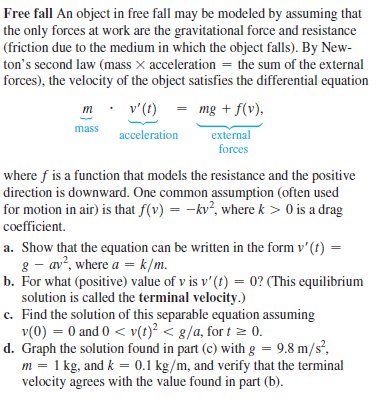Free fall An object in free fall may be modeled by assuming that the only forces at work are the gravitational force and resistance (friction due to the medium in which the object falls). By New- ton's second law (mass X acceleration = the sum of the external forces), the velocity of the object satisfies the differential equation m . v'(t) = mg + f(v), mass acceleration external forces where f is a function that models the resistance and the positive direction is downward. One common assumption (often used for motion in air) is that f(v) = -kv², where k > 0 is a drag coefficient. a. Show that the equation can be written in the form v' (t) = g – av?, where a = k/m. b. For what (positive) value of v is v' (t) = 0? (This equilibrium solution is called the terminal velocity.) c. Find the solution of this separable equation assuming v(0) = 0 and 0 < v(t)? < g/a, for t = 0. d. Graph the solution found in part (c) with g = 9.8 m/s, m = 1 kg, and k = 0.1 kg/m, and verify that the terminal velocity agrees with the value found in part (b).
Free fall An object in free fall may be modeled by assuming that the only forces at work are the gravitational force and resistance (friction due to the medium in which the object falls). By New- ton's second law (mass X acceleration = the sum of the external forces), the velocity of the object satisfies the differential equation m . v'(t) = mg + f(v), mass acceleration external forces where f is a function that models the resistance and the positive direction is downward. One common assumption (often used for motion in air) is that f(v) = -kv², where k > 0 is a drag coefficient. a. Show that the equation can be written in the form v' (t) = g – av?, where a = k/m. b. For what (positive) value of v is v' (t) = 0? (This equilibrium solution is called the terminal velocity.) c. Find the solution of this separable equation assuming v(0) = 0 and 0 < v(t)? < g/a, for t = 0. d. Graph the solution found in part (c) with g = 9.8 m/s, m = 1 kg, and k = 0.1 kg/m, and verify that the terminal velocity agrees with the value found in part (b).
Calculus: Early Transcendentals
8th Edition
ISBN:9781285741550
Author:James Stewart
Publisher:James Stewart
Chapter1: Functions And Models
Section: Chapter Questions
Problem 1RCC: (a) What is a function? What are its domain and range? (b) What is the graph of a function? (c) How...
Related questions
Question

Transcribed Image Text:Free fall An object in free fall may be modeled by assuming that
the only forces at work are the gravitational force and resistance
(friction due to the medium in which the object falls). By New-
ton's second law (mass X acceleration = the sum of the external
forces), the velocity of the object satisfies the differential equation
m . v'(t) = mg + f(v),
mass
acceleration
external
forces
where f is a function that models the resistance and the positive
direction is downward. One common assumption (often used
for motion in air) is that f(v) = -kv², where k > 0 is a drag
coefficient.
a. Show that the equation can be written in the form v' (t) =
g – av?, where a = k/m.
b. For what (positive) value of v is v' (t) = 0? (This equilibrium
solution is called the terminal velocity.)
c. Find the solution of this separable equation assuming
v(0) = 0 and 0 < v(t)? < g/a, for t = 0.
d. Graph the solution found in part (c) with g = 9.8 m/s,
m = 1 kg, and k = 0.1 kg/m, and verify that the terminal
velocity agrees with the value found in part (b).
Expert Solution
This question has been solved!
Explore an expertly crafted, step-by-step solution for a thorough understanding of key concepts.
This is a popular solution!
Trending now
This is a popular solution!
Step by step
Solved in 2 steps

Recommended textbooks for you

Calculus: Early Transcendentals
Calculus
ISBN:
9781285741550
Author:
James Stewart
Publisher:
Cengage Learning

Thomas' Calculus (14th Edition)
Calculus
ISBN:
9780134438986
Author:
Joel R. Hass, Christopher E. Heil, Maurice D. Weir
Publisher:
PEARSON

Calculus: Early Transcendentals (3rd Edition)
Calculus
ISBN:
9780134763644
Author:
William L. Briggs, Lyle Cochran, Bernard Gillett, Eric Schulz
Publisher:
PEARSON

Calculus: Early Transcendentals
Calculus
ISBN:
9781285741550
Author:
James Stewart
Publisher:
Cengage Learning

Thomas' Calculus (14th Edition)
Calculus
ISBN:
9780134438986
Author:
Joel R. Hass, Christopher E. Heil, Maurice D. Weir
Publisher:
PEARSON

Calculus: Early Transcendentals (3rd Edition)
Calculus
ISBN:
9780134763644
Author:
William L. Briggs, Lyle Cochran, Bernard Gillett, Eric Schulz
Publisher:
PEARSON

Calculus: Early Transcendentals
Calculus
ISBN:
9781319050740
Author:
Jon Rogawski, Colin Adams, Robert Franzosa
Publisher:
W. H. Freeman


Calculus: Early Transcendental Functions
Calculus
ISBN:
9781337552516
Author:
Ron Larson, Bruce H. Edwards
Publisher:
Cengage Learning